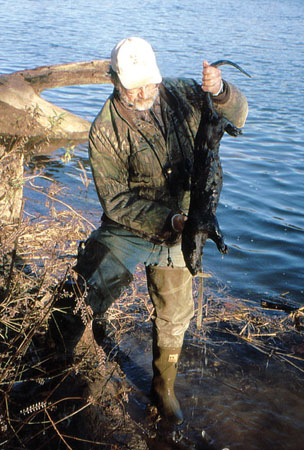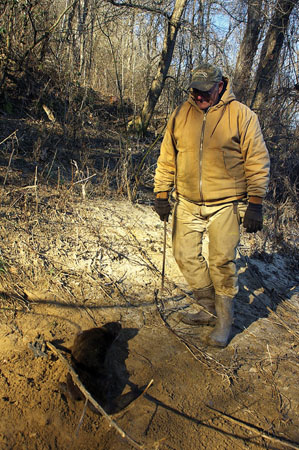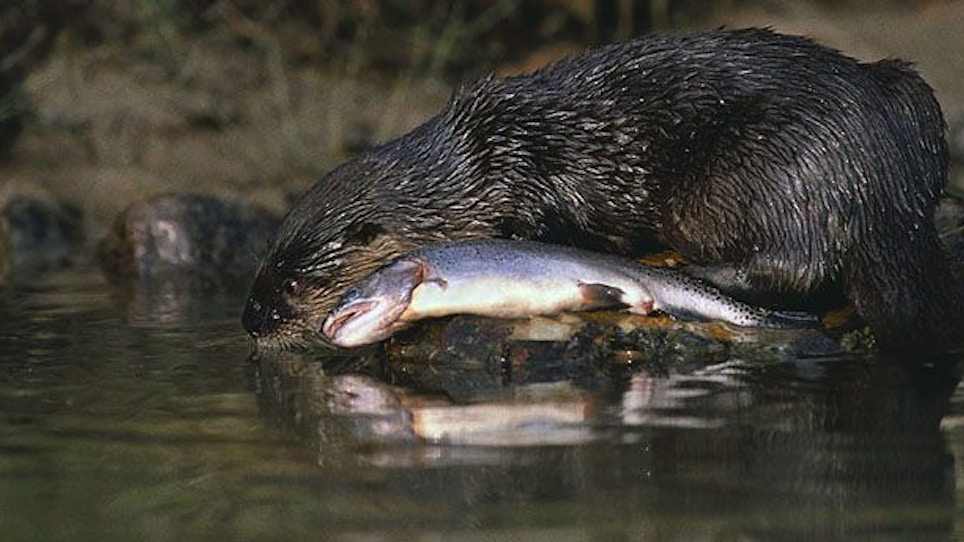 Otters — they are often depicted as cute, playful and as innocent as babes. In fact, the Great Smoky Mountains National Park, where the park has restored otters in recent decades, even uses them on promotional literature and to decorate newer, eco-friendly park vehicles. Looks and perceptions, however, are decidedly misleading when otters are in question. They are a consummate fish predator, one that eats with tremendous appetite and is also quite capable of killing for the pure joy of it. A mature otter will eat as much as 3 pounds of fish daily.
Otters — they are often depicted as cute, playful and as innocent as babes. In fact, the Great Smoky Mountains National Park, where the park has restored otters in recent decades, even uses them on promotional literature and to decorate newer, eco-friendly park vehicles. Looks and perceptions, however, are decidedly misleading when otters are in question. They are a consummate fish predator, one that eats with tremendous appetite and is also quite capable of killing for the pure joy of it. A mature otter will eat as much as 3 pounds of fish daily.
Mind you, this side of the otter's personality tends to be downplayed in a major way, at least in official wildlife circles. Repeatedly, I have read reports or talked to fisheries' biologists and usually their response falls into the generic "cover your butt" category. They avoid specifics, but assure you that otters dine primarily on crayfish, and when they do add fish to the menu, it is "trash fish" such as carp or suckers. That is — to put matters bluntly — pure, unmitigated, feel-good, bureaucratic B.S.
I have personally seen otters killing trout and steelhead with reckless abandon, and since they were restocked in my old home stomping grounds (the Great Smokies of east Tennessee and western North Carolina), one veteran angler after another has complained to me about their depredations. In North Carolina, not too many months ago, state wildlife officials got a thumping wake-up call on otter damage. Since the critters were restocked — mostly in the late 1980s and 1990s — complaints have been growing, but the only advice the North Carolina Wildlife Resources Commission (NCWRC) offered was to contact a local trapper.
One has to wonder if that might change now. Otters got into the Commission's Armstrong Creek trout hatchery, a major rearing facility for the fish used to stock mountain streams. Once they discovered the concrete runs filled with fish, carnage ensued. Overnight otters had a combination feast and killing frenzy resulting in the loss of thousands of dollars worth of fish destined for mountain streams, and paid for by sportsmen.
That is but one stark example of a growing problem affecting many areas of the country. Ironically, old timers saw it coming. When the Great Smoky Mountains National Park decided to begin restocking, as did the Tennessee Wildlife Resources Agency and NCWRC, a few of these folks who had always lived close to the land protested mightily. Their comments were pretty well summarized by the pithy pronouncement of one grizzled east Tennessean, "Hardy mountain folks worked for a hundred years to get rid of these blasted things, and now you fools want to bring 'em back." His suggestion — and that of others — was that restocking had the potential to pose major problems for sport fisheries. That is currently happening in a big way throughout a number of areas.
 Interestingly, our ancestors not only recognized the otter problem, but they addressed it in a straightforward fashion. One fascinating example of this comes from an unpublished document known as "The Swamp Journal of Fleetwood Lanneau." Henry Edwards Davis in his landmark book, The America Wild Turkey, has a number of references to Lanneau, and by great good fortune, several years back I had an opportunity to hunt the great bird on Davis's old stomping grounds along the Great Pee Dee River in South Carolina. At some point during my visit to what turkey hunters call hallowed ground, my host mentioned the name "Lanneau" and asked if I knew who he was. I indicated I was aware of him thanks to the Davis book, and he then asked, "How would you like to read his swamp journal?"
Interestingly, our ancestors not only recognized the otter problem, but they addressed it in a straightforward fashion. One fascinating example of this comes from an unpublished document known as "The Swamp Journal of Fleetwood Lanneau." Henry Edwards Davis in his landmark book, The America Wild Turkey, has a number of references to Lanneau, and by great good fortune, several years back I had an opportunity to hunt the great bird on Davis's old stomping grounds along the Great Pee Dee River in South Carolina. At some point during my visit to what turkey hunters call hallowed ground, my host mentioned the name "Lanneau" and asked if I knew who he was. I indicated I was aware of him thanks to the Davis book, and he then asked, "How would you like to read his swamp journal?"
Predictably, I rose to this verbal lure like a trout to a well-presented fly, and a few days later, a typescript prepared verbatim from Lanneau's original journal was delivered to me. It was a riveting and revealing account. Upwards of a century ago, Lanneau was paid to patrol a huge area along the Great Pee Dee as a sort of gamekeeper, overseer and predator-control expert. In the latter capacity, he went after otters with a vengeance. Rather than relying on trapping them though, he actively and successively hunted these lithe, elusive creatures.
Obviously, his employer considered otters a major problem, but they seem likely to pose a much bigger one in today's world. While otter pelts have at times in the last decade brought quite decent prices on the wildly erratic fur market, the undeniable fact is that not nearly as many folks trap as was the case 50 or 100 years ago. An acquaintance of mine, Marty Maxwell, is a veteran mountain fly fisherman who speaks in disgust about this change in the aftermath of having watched otters, in the course of only a couple of years, decimate the fish in what was once a prime brown trout stream. Maxwell summed things up in pointed fashion. "I reckon the stock is running down here in the hills," he said. "Nobody shoots or traps these blasted otters, and they are doing damage which wouldn’t have been allowed to pass two generations back."
One has to wonder what the future will hold, with greenie weenies insisting that otters are loveable creatures that everyone should consider almost sacred. When presented with this sort of dilemma, though, rather than acting on the emotion of the tree-hugger type, it is often wise to return to the past for insight. Historians know there is a lot of wisdom in the adage which suggests "you can’t know where you are going if you don’t know where you've been." Or, to put it another way — sometimes the law of unintended consequences kicks in when feel-good approaches to wildlife management include predator restoration. Hunters, ranchers, homeowners and state wildlife officials in Idaho, Montana and elsewhere are currently learning a hard, costly lesson in a similar regard with wolves. It seems quite likely the same general scenario, while one not as sensational or attention grabbing is unfolding with otters.
Maybe, just maybe, it's time to pause and ponder the wider ramifications of otter restoration. We are already reaping the whirlwind with wolves, and otters bid fair to present a similar situation.






